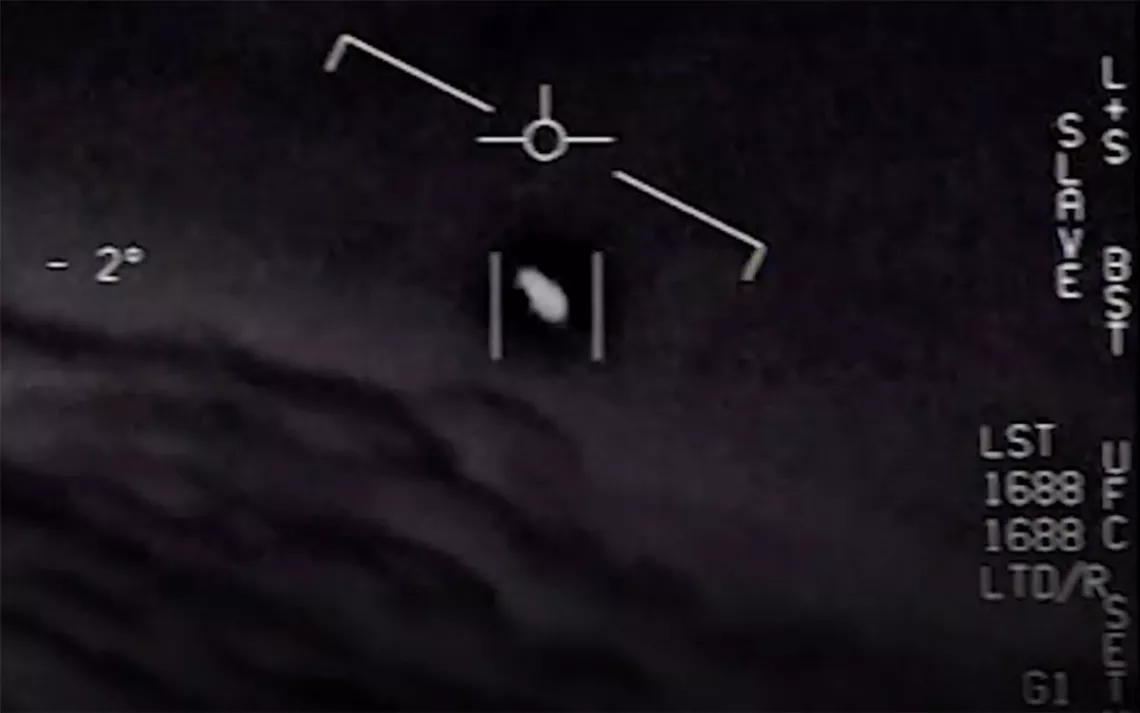June Stargazing: UFOs on the Horizon
UFO enthusiasts eagerly await a federal report

Photo courtesy of Department of Defense
Last month, while flipping aimlessly through channels, I came across a surprising segment on CNN. Chris Cuomo was interviewing retired US naval officer Sean Cahill and former deputy assistant secretary of defense for intelligence Christopher Mellon. The topic of their discussion was not foreign policy or the military but a forthcoming federal report, overseen by the secretary of defense and the director of national intelligence, which will contain, according to government documents, “detailed analysis of unidentified aerial phenomena data and intelligence”—in other words, UFOs. UFO enthusiasts hope the report, which was mandated in last year’s $2.3 trillion COVID relief bill, will finally shed some light on what they believe to be the government’s extensive and closely guarded knowledge of UFOs.
The interview was fascinating, particularly its final exchange, when Cuomo asked the two men what they thought could explain a number of recently declassified incidents in which US Navy fighter pilots encountered and tracked strange, cylindrical objects—often described as “Tic Tacs”—across the sky. These objects, according to the pilots, had no wings or tail fins and exhibited flight capabilities that far exceed that of any aircraft found on this planet, accelerating rapidly and turning at impossible angles. “Look at the resumes of these two guys,” Cuomo said, referring to his two guests. “They’re both saying [these objects] might be from another world.”
“There’s no scientific reason or basis to doubt that possibility,” replied Mellon, as calmly as if he were commenting on gravity. “That’s a hypothesis that could explain the facts. People need to be open to that. We’re spending billions looking for extraterrestrial civilizations. We’ve got spacecraft that have already left the solar system. It’s possible that someone found us before we found them.”
Few topics stir as much interest, and controversy, as UFOs and their counterpart, aliens. For more than a century, little green men and their ilk have become an industry unto themselves, the subjects of hundreds of books, radio programs, movies, and television shows. Aliens play on deeply ingrained facets of the human mind—our curiosity about what lies beyond our small planet, and our uncertainty about where we belong in a massive and seemingly indifferent universe. As renderings of our hopes and anxieties, they come in many forms. Sometimes they are gentle and misunderstood companions, as in Steven Spielberg’s E.T.; in other cases, they are fearful and ravaging monsters, as immortalized in Ridley Scott’s Alien and the recent film A Quiet Place.
Imagining beings from outer space is said to be a fairly recent phenomenon in human history, dating roughly to the advent of the telescope in the 17th century. But my own experience has made me question that notion. Several years ago, while on a rafting trip in Utah’s remote Desolation Canyon, I came across a towering sandstone alcove with huge, alien-like figures pecked into the redrock. These forms, drawn by the Fremont people anywhere from 700 to 2,000 years ago, are a common type of petroglyph found in the canyonlands of the Colorado Plateau, known to specialists as “anthropomorphs.” Atop the trapezoidal bodies of the figures that I saw sat small heads with large, goggle eyes and insect-like antennae. From these antennae emanated squiggly and dashed lines, suggesting some type of signal beaming out from their heads and into the ether. Had the Fremont people been visited by creatures from another planet? Were they daydreaming about otherworldly beings? It’s quite possible that the images represented something else entirely—spirits or ancestors, perhaps—and I was merely superimposing my own sensibility, imbuing them with a meaning that would have been unfathomable to the ancient artists.
Carl Sagan asserted that our conception of extraterrestrials is deeply ingrained and ultimately traceable to a childhood belief in monsters. People who claim to have been abducted by UFOs, Sagan writes in The Demon-Haunted World, “frequently report having seen ‘aliens’ in their childhood—coming in through the window or from under the bed or out of the closet.” Sagan admits that he, himself, experienced similar “hallucinations” in his own childhood. Those experiences, he suggests, provided him with a kind of intellectual tension between the desire to know the deepest secrets of the universe and the sober, stepwise nature of scientific methodology that propelled his entire career. “Everything hinges on the matter of evidence,” Sagan writes. “On so an important question, the evidence must be airtight. The more we want it to be true, the more careful we have to be.”
During the coronavirus pandemic, sightings of UFOs (or, the less evocative UAPs, or “unidentified aerial phenomena”) increased nationwide by more than 15 percent according to The New York Times. The most convincing explanation seems to be that city dwellers—fleeing in large numbers to rural regions and suddenly exposed to dark skies—were simply overwhelmed by the proliferation of stars. The uptick in sightings is also surely related to the dramatic increase in satellites orbiting Earth in recent years. Some of the most frequently reported “UFOs,” it turns out, are SpaceX’s Starlink satellites, which traverse the sky in long, linear, flickering dashes.
And yet, the idea of alien visitation is gathering adherents, even among the ranks of the typically skeptical—scientists themselves. Earlier this year, for example, Harvard scientist Avi Loeb released Extraterrestrial: The First Sign of Intelligent Life Beyond Earth. The book focuses on a strange object detected by telescopes in 2017. Most astronomers believe the object, later dubbed ‘Oumuamua, was an oblong meteorite. But Loeb proposed that it might have been an alien vessel, powered by starlight, whizzing through our solar system.
At this moment in history, we seem primed, politically, culturally, and scientifically, to accept the idea that we are likely not alone in the cosmos. But that revelation brings us to an inescapable paradox, the observation of which is often attributed to the physicist Enrico Fermi: The size of the universe virtually guarantees that there is intelligent life out there; but that same size also ensures that, given the limitations of our current technology, we won’t be finding it on our own anytime soon.
Of course, there is no paradox if aliens have already found us. But if they know we are here, then why have they been so hesitant to make themselves known? One wild explanation, the “zoo hypothesis,” holds that Earth may be a sort of terrarium and that we are unwitting captives of a higher race in a planetary menagerie. In the CNN interview, Christopher Mellon articulated this idea in stark terms when Cuomo asked him why, if the aliens are smart enough to come here and have such advanced technologies, they haven't yet talked to us.
“Well, if they are that smart, what would they have to learn from us?” Mellon replied. “When you go to the zoo, do you talk to the animals?”
WHAT TO LOOK FOR IN JUNE
Toward the end of the month, the positions of the stars begin to shift into their summer configurations. As you step out into the darkness at sundown, notice that Ursa Major, or the Big Dipper, is now almost directly overhead. One of the most fascinating stars in the Northern Hemisphere lies in Ursa Major. To get a glimpse of it, find the handle of the dipper, which is comprised of three stars. Train your sights on the middle star, Mizar. In Arabic, Mizar translates to something like “apron,” which is fitting since this object is, in fact, five individual stars hemmed into a complex orbital pattern around one another. One of its companions, Alcor, can be distinguished with the naked eye. To see the rest of the stars in the system, however, a telescope is necessary. A good telescope will “split” Mizar into two stars like Russian matryoshkas. But more powerful instruments have revealed that those two stars are, themselves, binary pairs, orbiting each other in a magnificent celestial dance.
One of the most majestic objects in the summer sky, M13, is found in the constellation Hercules, which will rise almost directly overhead this month. Also called the Hercules Cluster, this giant assemblage of stars is located 500 million light-years away, just beyond the borders of our galaxy. Known as a globular cluster, it is one of roughly 150 glittering gatherings of stars found in a disc, or apron, around our own Milky Way. While scientists still do not fully understand the physics of their formation, one hypothesis is that globular clusters are born when galaxies collide. In a dark location, you can detect the Hercules Cluster with a pair of binoculars, though it will show up best through a telescope. To find it, look for two of the brightest stars in the summer sky, Vega and Arcturus. About halfway between them is a small trapezoid of stars, known as the “keystone” of Hercules. Scan the sky around the top, left star. There you will find the large, spidery wisp of stars, M13. With an astrophotography camera, however, the beauty of the Hercules Cluster is revealed.
On June 24, the full moon, known as the Strawberry Moon will rise overhead. According to the Old Farmer’s Almanac, the Haida people of the Pacific Northwest call it, similarly, the “Berries Ripen Moon,” signaling the time of year in which wild berries could be gathered from the forests.
 The Magazine of The Sierra Club
The Magazine of The Sierra Club



